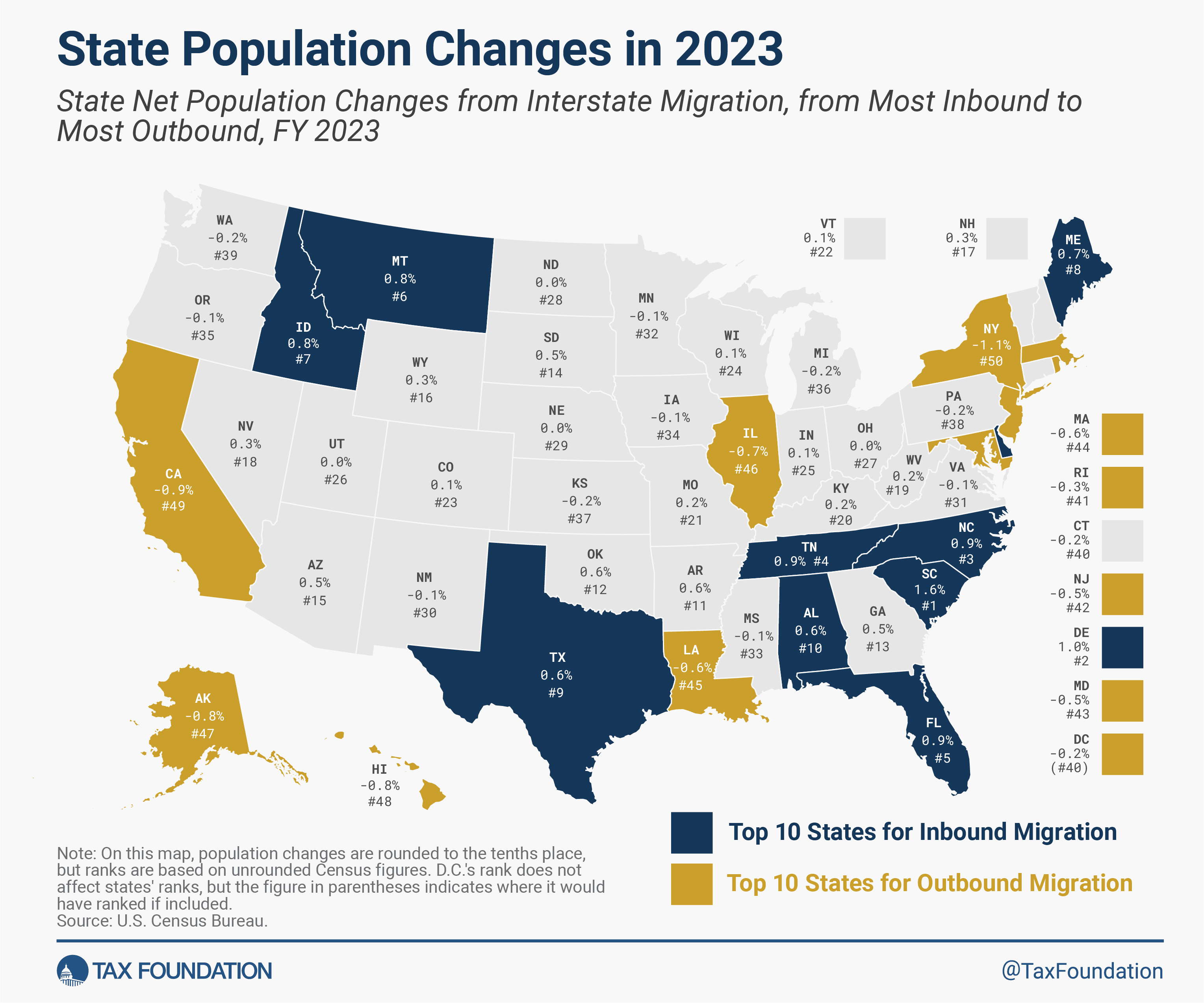Employment Declines for the 7th Straight Month: Louisiana Economic Situation January 2024
Louisiana’s economy needs a comeback. While there are many reasons why, a major reason is that the state has now had a declining population for seven straight years, and employment has declined for six consecutive months. While there are positive indicators on the surface, the reality is much different for many Louisianans.
Let’s dive into the data and see what’s going on.
The Pelican State has abundant resources, but many failed public policies keep Louisianans from flourishing.
Louisiana’s population declines again as people move to other states.
The U.S. Census Bureau recently released population data for each state. Louisiana’s population declined in 2023 by 14,274 people to 4.57 million. Making matters worse, this was the seventh consecutive year that Louisiana’s population has declined to a total of 107,000 fewer people residing here since 2016.
The new data also provides net domestic migration, telling us how many people enter or exit the Pelican State from other states. Figure 1 shows how Louisiana had the sixth largest outmigration to other states. The net outmigration for 2023 was 29,692 people, representing a 0.6% decline.
Figure 1: Louisiana had the Sixth Largest Net Outmigration
Source: Tax Foundation
But that’s not the worst part; the state has had net outmigration for at least the last four years, with 110,709 people fleeing Louisiana for another state since 2020. This is a terrible trend for the state as families are broken up, people with higher skills and incomes typically leave, and the economy suffers.
Of course, these declines in the population make many of the labor market measures look better than they would have had these people stayed in Louisiana.
The U.S. Bureau of Labor Statistics recently released Louisiana’s labor market data for December to help us evaluate how people are doing across the state.
Louisiana’s unemployment rate would be 5.5% if the working-age population hadn’t declined since February 2020 instead of the reported 3.7% rate.
- Since February 2020, before the COVID-19 lockdowns, the working-age population has declined by 38,599 people to 3.54 million. The labor force has declined by 458 people since then to 2.09 million and is down 28,315 people since the recent peak of May 2023.
- Considering if the working-age population hadn’t declined but were in the labor force and unemployment, the unemployment rate would be 5.5%, much higher than the reported 3.7% rate.
- If the working-age population hadn’t declined, the labor force participation rate would be 59.3% instead of the 58.9% rate today.
Louisiana’s employment level from the household survey shows it has declined in seven straight months for a total decline of 29,450 jobs since May 2023.
- The establishment survey shows that nonfarm employment has declined by 18,700 to 1.97 million jobs in December 2023 since pre-COVID lockdowns, making it one of a few states with fewer people employed since then.
- The household survey shows that employment is down by 458 jobs to 2.09 million since February 2020.
- In December, nonfarm employment increased by 3,300 (4th largest percentage increase by 0.2% of any state, as 20 states had declines or essentially no growth).
- But the household survey showed employment declined by 4,184 jobs in December, the seventh month in a row of declines in employment for a total decline of 29,450 jobs since May 2023.
Louisiana workers’ purchasing power continues to decline across most industries.
- Even with the recent nonfarm job losses, they are up by 37,300 jobs over the last year for a 1.9% increase (11th fastest). Over the last year, private sector jobs have been up 1.6%, and government jobs are up 2.2%.
- In December, jobs in the private sector increased by 2,600 jobs to 1.65 million, and government employment increased by 700 jobs to 320,300.
- There is growing weakness in the labor market, with job losses and average weekly earnings not rising as fast as CPI inflation of 3.2% in many industries (Figure 2).
Figure 2. Louisiana’s Labor Market by Industry
Source: U.S. Bureau of Labor Statistics
Economic growth has picked up, but personal income lags the U.S. average.
- The Bureau of Economic Analysis (BEA) recently reported that annualized growth in real GDP in Louisiana was +6.6% in Q3:2023 (above the 4.9% U.S. average) ranked 5th best in the country to $240.1 billion.
- Figure 3 illustrates what BEA reported for personal income growth by state. Louisiana’s grew at an annualized pace of +3.1% (ranked 29th) to $261.4 billion in Q3:2023 (below +3.5% U.S. average).
Figure 3: Personal Income Growth by State in Q3:2023
Source: U.S. Bureau of Economic Analysis
Bottom Line: Louisiana’s economy shows some signs of strength when you look at the broader economy. But those gains do not reflect what is going on in the labor market so there is likely going to be less growth in the economy soon with more job losses to come. Given these results, there will not be improvements in the state’s poor business tax climate, net out-migration of Louisianans, or Louisiana having one of the highest poverty rates in the country—unless bold, pro-growth reforms are enacted soon.
These bold reforms include:
- Passing a Responsible Louisiana Budget this year that grows the budget by less than the rate of population growth plus inflation to allow for sustainable budgeting and tax reform.
- Following the Pelican Institute’s “Comeback Agenda” that encourages spending restraint, tax reform, regulatory relief, education freedom, a revamp of workforce and social safety net programs, and more.
- This is not only what Louisiana needs; it’s what Louisianans want, as noted in a recent poll.It’s Geaux Time! To learn more about the state’s economy and what can be done to fix it, register today for Pelican’s Solutions Summit on March 7 in Baton Rouge.
